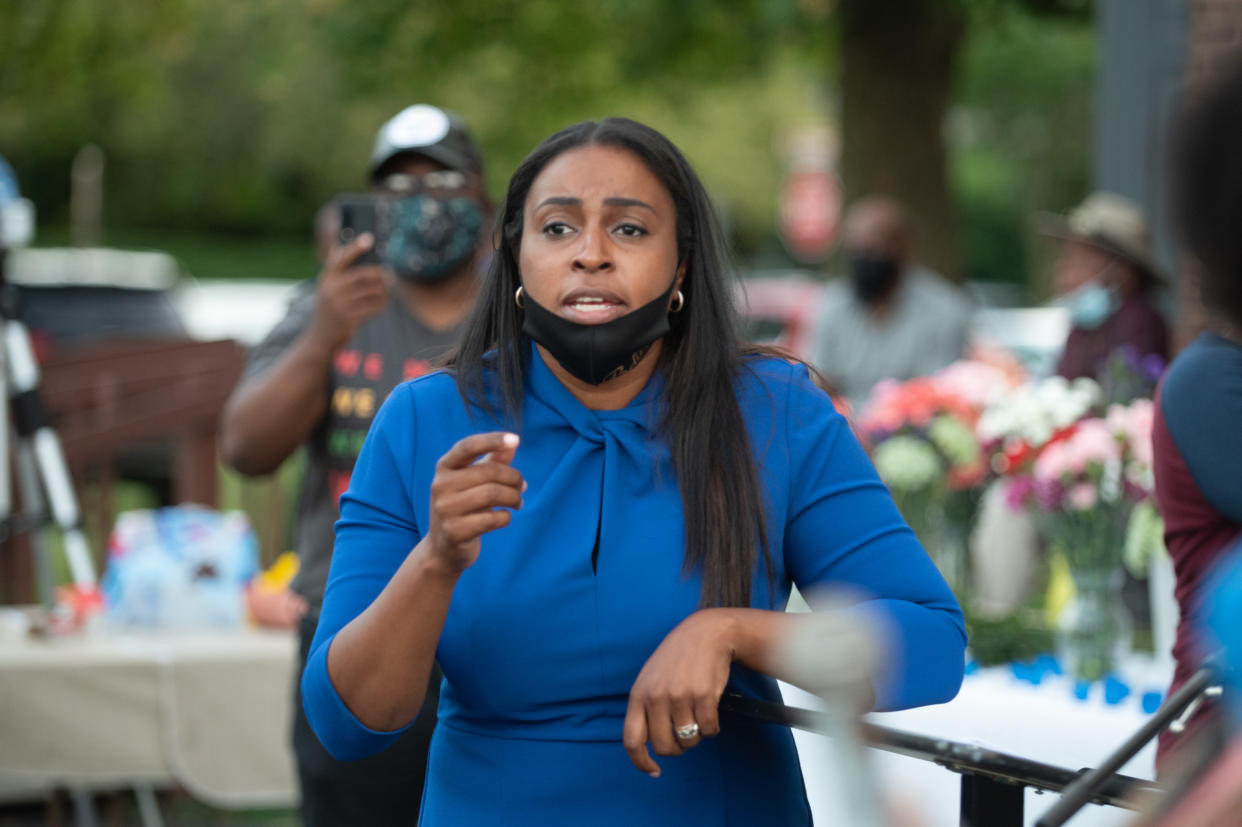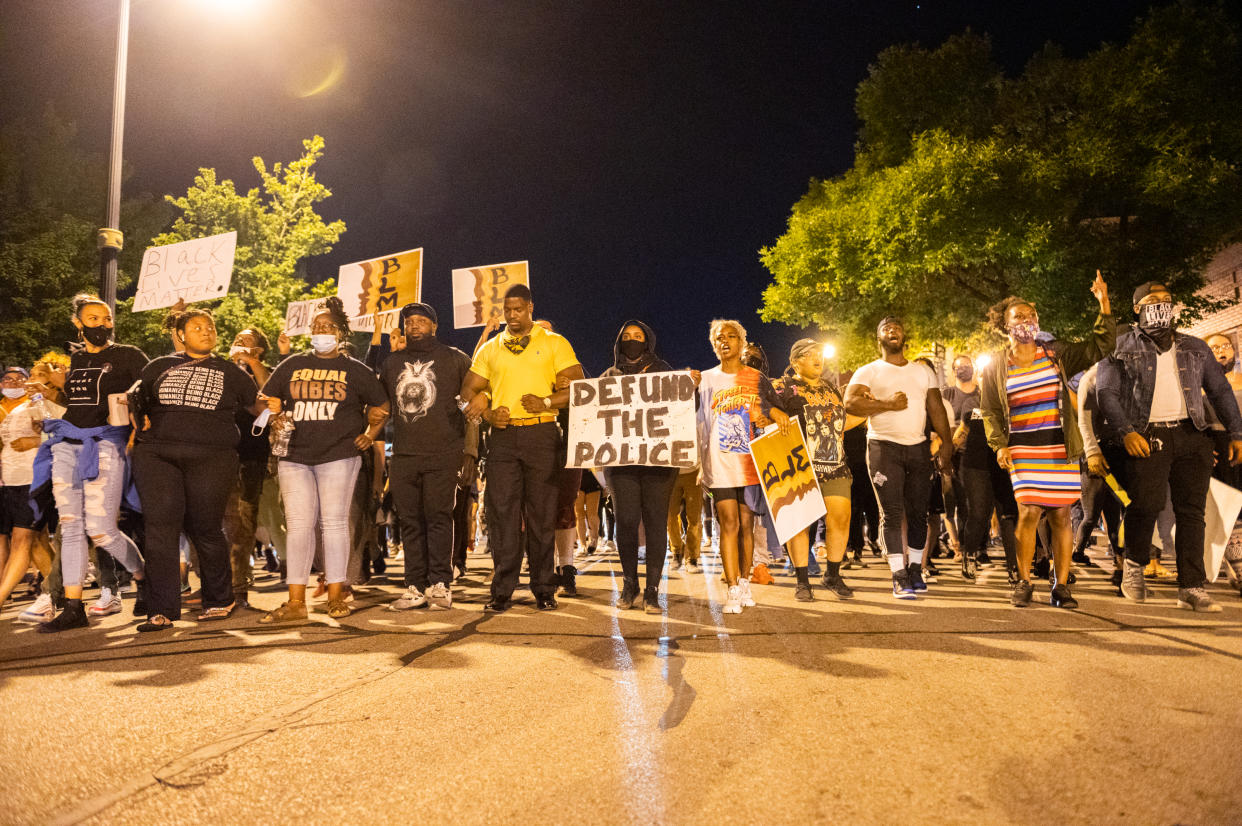Rochester official says police instigated clash with racial justice protesters
A newly surfaced video of a Black man dying in police custody in Rochester, N.Y., has sparked another wave of protests against police violence and systemic racism. On Wednesday, the family of Daniel Prude released a video of the 41-year-old being asphyxiated in police custody.
Prude — who was suffering from mental health problems — died on March 23, but the incident was unknown to the public until this week when his family released body-camera footage they had acquired via a records request.
In the 88 minutes of video, Prude did not appear to offer physical resistance to the group of officers present. He was naked when officers cuffed him and placed him on the ground.
As he became agitated, however, Prude began spitting at the officers, who then put a “spit hood” over his head. At that point, officers began pushing him into the pavement, and he became unresponsive.
On Thursday, Rochester Mayor Lovely Warren announced that the seven officers involved would be suspended with pay and that Police Chief La’Ron Singletary had not accurately informed her of the details of the incident. Warren also claimed she didn’t see footage of the incident until early August.
Warren added that the city was in talks with Prude’s family lawyers about settling a pending lawsuit.
On Thursday evening, videos taken by demonstrators and journalists showed state and local police battling protesters who had gathered outside the city’s Public Safety Building to protest Prude’s death. Officers fired pepper balls into the crowd and arrested eight protesters, according to the Democrat & Chronicle, a local paper. Rochester police also said that two officers were injured in the confrontations.

Local officials on Friday criticized the actions of the Rochester police and the confrontations with protesters. “It’s clear that the City Council’s request for a respectful, de-escalated interaction with protesters went unheeded,” council member Mitch Gruber told the Democrat & Chronicle. “[Rochester police] initiated unnecessarily aggressive behavior toward peaceful protesters.”
On Friday morning, Yahoo News spoke to City Council member Mary Lupien, who was present at the protest Thursday night. The interview is edited for length and clarity.
Yahoo News: What has been happening in the city over the last few days that led to the demonstrations last night?
Lupien: Two days ago the community found out that we had a killing in custody, that after viewing the footage is beyond-words disturbing about how this man was treated inhumanely, and the manner of his death was very similar to George Floyd’s.
At our budget hearing about two months ago, the community had been asking — after the killing of George Floyd — to cut the police budget, and the mayor and police chief all made statements to the effect of “We don’t have these kind of problems here. We’re ahead of the curve, we’re not Minneapolis,” all the while knowing that this had happened.
It was shocking to the community to find out that it had been kept secret for so long and to really not have the mayor or police chief give adequate answers as to why. It was stated that [state] Executive Order 147 precluded them from speaking about it, but that’s actually not what it says.
The officers were still on active duty, and it was said that because the [New York state] attorney general had taken over the investigation that the city wasn’t allowed to discipline. The attorney general came back and said, “No, actually, please do hold your own investigation.” So the community really hasn’t been given an apology or seen parties held accountable.

The actual demonstrations started, unfortunately, after [activist group] Free the People Roc held their press conference to let people know about [the footage of Prude dying] along with the family of Daniel Prude. The mayor was [also] going to hold her own press conference, and the family and Free the People Roc would be in attendance.
Instead of showing up, the mayor held it at a different location. And when the activists and family tried to attend that press conference, they were barred from attending. And in trying to attend, some of the organizers were arrested, one of them especially in a violent manner.
When [local activist] Stanley Martin was arrested, she asked the officer, “Why are you arresting me?” and he said, “Because you’re an idiot.” And so consistently the police have been escalating the situation instead of treating the community with respect and dignity.
That really started the first protest, because people were just gathering to demand the release of the Free the People Roc organizers. [The Thursday night protests occurred] because there was a community meeting being held outside the church, and it was taken over by activists because whatever the answers they felt they were going to get weren’t enough.
That’s what really led to the scene last night. It was very peaceful when it was over on Jefferson Avenue, where the killing occurred. When it moved to the Public Safety Building, that’s when the police came out in militaristic force, and I was actually there and saw the escalation when they were really macing and pepper-spraying for no apparent reason and instigating the crowd, which escalated the situation.
I was there around 10:45 last night, just on the side, filming and observing. And when they started shooting the crowd with pepper balls, I turned around to walk away and was shot in the back.
So you didn’t see anything that preceded the police action against attendees from the side of the demonstrators?
Initially, but as the scene escalated, the crowd started throwing water bottles and rattling the fence. I can’t say there wasn’t an escalation on both sides, but from the very beginning of this after the press conference the police were preparing for war. They had called in state troopers. There were hundreds of police in full riot gear setting up the barriers, when there were just news cameras and 20 people across the street. When you prepare for that militaristic response, you invite it.

When was the request from the council asking police to not use pepper balls?
We sent that out [Thursday] early afternoon.
And they used them Thursday night?
They did. And I was hit by one.
Have the mayor and police chief explained the position they took on how Rochester was different — knowing, at that time, there had been a death similar to George Floyd’s?
The mayor has said that her statements were about accountability and instituting some of the “8 Can’t Wait” reforms and President Obama’s recommendations; that’s where she said she was coming from, but clearly the perception was that we didn’t have police brutality problems here. For the police chief to say that, knowing what had happened — the police union president just four days ago said we don’t have the type of problems here that other cities have, all the while knowing, I think it’s very clear, that it was misleading.
You have mentioned that there has been conflicting information about why some officers aren’t displaying their name or badge number. Could you explain what’s going on with that?
We have some people in the community that have been expressing outrage that officers are covering their badges, and we were told that this was a practice called a “mourning band.” When there’s a fallen officer anywhere, [a black band is] put over [police identification badges], and when the officer’s funeral happens, then they take it off.
So this is absolutely not for their safety. It wasn’t a uniform practice either, as some had it covered and some didn’t. A community member who was put in touch with the department was told that “this is a practice for mourning bands, and we’re not stopping.” They were very defensive of the practice, and it’s not about officer safety.
The Democrat & Chronicle reported that a police spokesperson told it that “the removal of name tags or covering of sewn nameplates with tape was an issue of officer safety.”
I had not heard that until I saw it in print, but I have the emails that state the policy for mourning bands.

What are some steps that you can take as a council member, or that the mayor or other officials could take, that would improve the situation there in the short term?
That’s going to be difficult because it’s been allowed to escalate so much. The unlikely situation, first of all, that the mayor and police chief take responsibility for knowing and not telling the community and being honest, that would go a long way. The officers right now are on administrative leave with pay. I think if they were fired, that would also go a long way for the community to feel like these people are being held accountable.
Going forward, we are looking at a mental health emergency response force to respond to these types of incidents instead of police. There has been buy-in, but there seems to be more since the incident into the CAHOOTS [a Eugene, Ore., program that deploys first responders trained to deal with mental health problems] model, and we’re talking with the county to see how we could retool or resource an existing forensic intervention team that does this work in a slightly different way.
I think that would be absolutely one way going forward, but really there are so many reforms that need to happen in hiring and recruitment and selection of officers. We are in the middle of a negotiation for the union contract, which has a lot of giveaways and things we’d like to change, and ultimately I’d like to see, and many in the community would like to see, a reduction in the force.
What do you think the situation looks like in the city Friday night?
That’s a good question — I really don’t know. I’m trying to do what I can to set up kind of a testimony so that the community can express how they’re feeling about the RPD, what they’ve gone through; people just really want to be heard, and that potentially could deescalate a little bit. It really depends on the police response tonight. If they come out in military gear and are antagonistic, I don’t know what’s going to happen.
Going beyond policy and procedures, there’s a real lack of respect for our community at the hands of [Rochester police]. Of course, it’s not everyone, but this is one of many incidents that I’ve heard of and I’ve personally witnessed that people in our community are not treated with respect and dignity, and that needs to be addressed if we’re going to go forward. I believe that the absolute disregard for Prude’s humanity in the video is inexcusable.
_____
Read more from Yahoo News:

